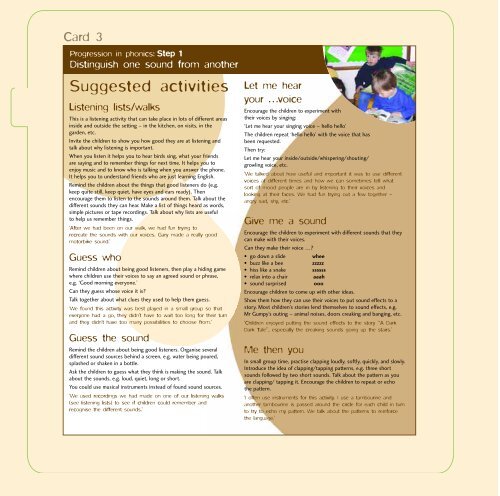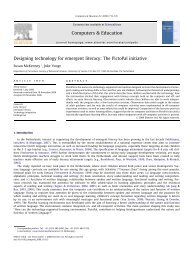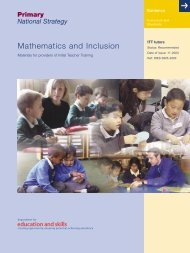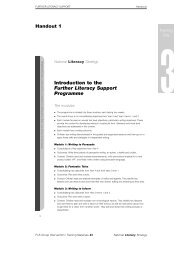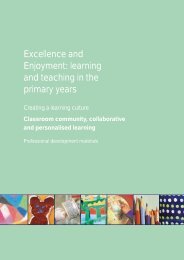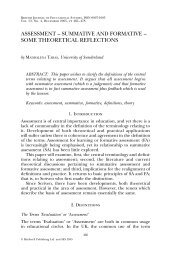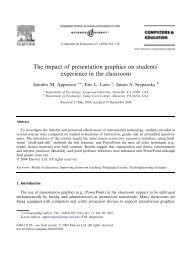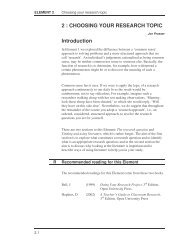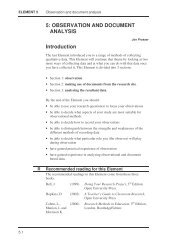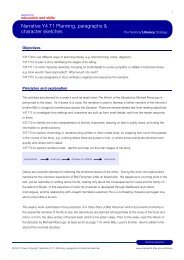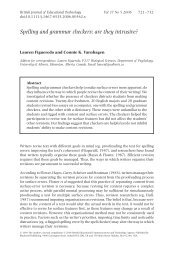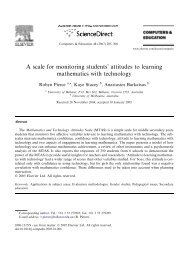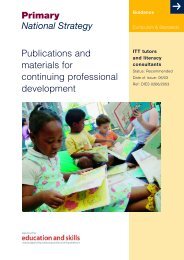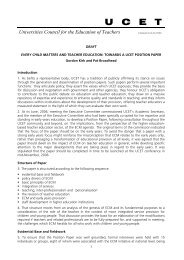A supplement to progression in phonics (cards) 1-3 - PGCE
A supplement to progression in phonics (cards) 1-3 - PGCE
A supplement to progression in phonics (cards) 1-3 - PGCE
Create successful ePaper yourself
Turn your PDF publications into a flip-book with our unique Google optimized e-Paper software.
Card 3<br />
Progression <strong>in</strong> <strong>phonics</strong>: Step 1<br />
Dist<strong>in</strong>guish one sound from another<br />
Suggested activities<br />
Listen<strong>in</strong>g lists/walks<br />
This is a listen<strong>in</strong>g activity that can take place <strong>in</strong> lots of different areas<br />
<strong>in</strong>side and outside the sett<strong>in</strong>g – <strong>in</strong> the kitchen, on visits, <strong>in</strong> the<br />
garden, etc.<br />
Invite the children <strong>to</strong> show you how good they are at listen<strong>in</strong>g and<br />
talk about why listen<strong>in</strong>g is important.<br />
When you listen it helps you <strong>to</strong> hear birds s<strong>in</strong>g, what your friends<br />
are say<strong>in</strong>g and <strong>to</strong> remember th<strong>in</strong>gs for next time. It helps you <strong>to</strong><br />
enjoy music and <strong>to</strong> know who is talk<strong>in</strong>g when you answer the phone.<br />
It helps you <strong>to</strong> understand friends who are just learn<strong>in</strong>g English.<br />
Rem<strong>in</strong>d the children about the th<strong>in</strong>gs that good listeners do (e.g.<br />
keep quite still, keep quiet, have eyes and ears ready). Then<br />
encourage them <strong>to</strong> listen <strong>to</strong> the sounds around them. Talk about the<br />
different sounds they can hear. Make a list of th<strong>in</strong>gs heard as words,<br />
simple pictures or tape record<strong>in</strong>gs. Talk about why lists are useful<br />
<strong>to</strong> help us remember th<strong>in</strong>gs.<br />
‘After we had been on our walk, we had fun try<strong>in</strong>g <strong>to</strong><br />
recreate the sounds with our voices. Gary made a really good<br />
mo<strong>to</strong>rbike sound.’<br />
Guess who<br />
Rem<strong>in</strong>d children about be<strong>in</strong>g good listeners, then play a hid<strong>in</strong>g game<br />
where children use their voices <strong>to</strong> say an agreed sound or phrase,<br />
e.g. ‘Good morn<strong>in</strong>g everyone.’<br />
Can they guess whose voice it is?<br />
Talk <strong>to</strong>gether about what clues they used <strong>to</strong> help them guess.<br />
‘We found this activity was best played <strong>in</strong> a small group so that<br />
everyone had a go, they didn’t have <strong>to</strong> wait <strong>to</strong>o long for their turn<br />
and they didn’t have <strong>to</strong>o many possibilities <strong>to</strong> choose from.’<br />
Guess the sound<br />
Rem<strong>in</strong>d the children about be<strong>in</strong>g good listeners. Organise several<br />
different sound sources beh<strong>in</strong>d a screen, e.g. water be<strong>in</strong>g poured,<br />
splashed or shaken <strong>in</strong> a bottle.<br />
Ask the children <strong>to</strong> guess what they th<strong>in</strong>k is mak<strong>in</strong>g the sound. Talk<br />
about the sounds, e.g. loud, quiet, long or short.<br />
You could use musical <strong>in</strong>struments <strong>in</strong>stead of found sound sources.<br />
‘We used record<strong>in</strong>gs we had made on one of our listen<strong>in</strong>g walks<br />
(see listen<strong>in</strong>g lists) <strong>to</strong> see if children could remember and<br />
recognise the different sounds.’<br />
Let me hear<br />
your …voice<br />
Encourage the children <strong>to</strong> experiment with<br />
their voices by s<strong>in</strong>g<strong>in</strong>g:<br />
‘Let me hear your s<strong>in</strong>g<strong>in</strong>g voice – hello hello’<br />
The children repeat ‘hello hello’ with the voice that has<br />
been requested.<br />
Then try:<br />
Let me hear your <strong>in</strong>side/outside/whisper<strong>in</strong>g/shout<strong>in</strong>g/<br />
growl<strong>in</strong>g voice, etc.<br />
‘We talked about how useful and important it was <strong>to</strong> use different<br />
voices at different times and how we can sometimes tell what<br />
sort of mood people are <strong>in</strong> by listen<strong>in</strong>g <strong>to</strong> their voices and<br />
look<strong>in</strong>g at their faces. We had fun try<strong>in</strong>g out a few <strong>to</strong>gether –<br />
angry sad, shy, etc.’<br />
Give me a sound<br />
Encourage the children <strong>to</strong> experiment with different sounds that they<br />
can make with their voices.<br />
Can they make their voice …?<br />
• go down a slide whee<br />
• buzz like a bee<br />
zzzzz<br />
• hiss like a snake ssssss<br />
• relax <strong>in</strong><strong>to</strong> a chair aaah<br />
• sound surprised ooo<br />
Encourage children <strong>to</strong> come up with other ideas.<br />
Show them how they can use their voices <strong>to</strong> put sound effects <strong>to</strong> a<br />
s<strong>to</strong>ry. Most children’s s<strong>to</strong>ries lend themselves <strong>to</strong> sound effects, e.g.<br />
Mr Gumpy’s out<strong>in</strong>g – animal noises, doors creak<strong>in</strong>g and bang<strong>in</strong>g, etc.<br />
‘Children enjoyed putt<strong>in</strong>g the sound effects <strong>to</strong> the s<strong>to</strong>ry “A Dark<br />
Dark Tale”, especially the creak<strong>in</strong>g sounds go<strong>in</strong>g up the stairs.’<br />
Me then you<br />
In small group time, practise clapp<strong>in</strong>g loudly, softly, quickly, and slowly.<br />
Introduce the idea of clapp<strong>in</strong>g/tapp<strong>in</strong>g patterns, e.g. three short<br />
sounds followed by two short sounds. Talk about the pattern as you<br />
are clapp<strong>in</strong>g/ tapp<strong>in</strong>g it. Encourage the children <strong>to</strong> repeat or echo<br />
the pattern.<br />
‘I often use <strong>in</strong>struments for this activity. I use a tambour<strong>in</strong>e and<br />
another tambour<strong>in</strong>e is passed around the circle for each child <strong>in</strong> turn<br />
<strong>to</strong> try <strong>to</strong> echo my pattern. We talk about the patterns <strong>to</strong> re<strong>in</strong>force<br />
the language.’


